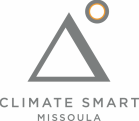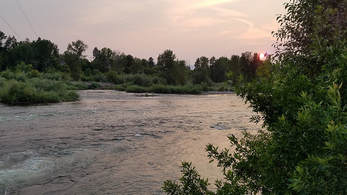 Summer smoky skies along the Clark Fork in Missoula. (Photo: Abby Huseth) Summer smoky skies along the Clark Fork in Missoula. (Photo: Abby Huseth) Call me biased, but our monthly meetups are pretty great. I think you’d be hard pressed to find a more interesting and wide-ranging conversation anywhere in town. Where else can you talk about pumped hydro energy storage technology, the virtues of lentil farming, the perils of human urine, and industrial-scale composting, all in the span of an hour and a half? If you couldn’t tell, the common thread running through these subjects is water – more specifically, the implications of climate change when it comes to our rivers, our drinking water, and our wastewater. That was the theme on tap for our August 2, 2018 monthly meetup - here's a recap of our conversation. Our Rivers Alex and Katie from the Clark Fork Coalition joined us to talk about what they’re seeing along the Clark Fork, here in town but also throughout our larger watershed. Alex was one of the authors of the Montana Climate Assessment, so he knows his stuff. CFC measures water all over the river, and this year there was a record snowpack in the upper Clark Fork, and a fairly wet spring. But this July was also the second driest on record – which, sure enough, was what the MT Climate Assessment predicted. Despite this lack of rainfall, we’re still seeing decent flow levels and relatively cooler water temperatures all along the Clark Fork because of something you might not have guessed: groundwater. In fact, we learned that 90% (!) of a watershed’s waterflow is actually underground. Whoa. So despite the trend of more spring precipitation and longer droughts in our region, the snowpack and rain may end up boosting the “natural storage” capacity of the watershed. That might sound good, but we’re definitely not out of the woods climate-wise when it comes to our rivers. Hotter temperatures mean higher rates of evapotranspiration, thus plants need more water to grow. More study is needed on what this means for the long-term evolution of our forest ecology. Alex reminded us that 95% of our state’s water use is due to agriculture. This is where we wade into the complicated realm of water rights and Helena lobbying interests, and then wade right back out again, because we could really get stuck there. Suffice to say, even when a rancher wants to return their water right to in-stream, it’s super hard to do. And most of the agriculture in our state is low-value commodity ag, so it’s hard to economically justify efforts to conserve water. What we could really use is more lentils! No, seriously – legumes and other dry-farmed products are a growing sector of Montana agriculture, which is pretty cool, and water smart. (Check out the Lentil Underground!) Ok, one last interesting issue at the nexus of water and climate that I hadn’t considered before. Katie from CFC talked about their recent studies on recreation on the Clark Fork river. As we experience more heat waves during the summer, more and more people are using the river to cool down. On one hand, dunking in the river is better than cranking the A/C. But in addition to bumper-to-bumper tube traffic on certain sections of the river, more river recreators means streambank erosion, more trash, and an overabundance of human urine. Yep. So it’s possible that we might we need more official river access points…with port-a-pottys. Thanks, climate change!
Avoiding overwatering outdoors is important too (those subdivided ranchettes with giant lawns don’t help...), but by all means keep your veggie patch green and water your trees - we need them to keep our city cool! If you’ve ever wondered about graywater systems (where water from sinks and laundry is recycled, either to flush toilets or for irrigation), they are allowed here but you’ll want to read up on the rules and regulations. 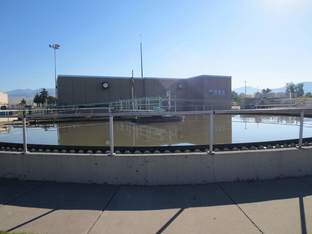 A primary treatment pond at the WWTP where most of the bio-waste settles before it is dewatered and composted. (Photo: Mattie Lehman) A primary treatment pond at the WWTP where most of the bio-waste settles before it is dewatered and composted. (Photo: Mattie Lehman) Our Wastewater Treatment Plant Rocks! So, what about that last piece of the water+energy puzzle – the treatment of our sewage and wastewater? Turns out, our humble little municipal wastewater treatment plant is light years ahead of most facilities around the country! Our intern Mattie shared what she recently learned on a tour, which was that there’s resource recovery happening with all three different waste streams created by the plant: the bio-solids (solid waste), the effluent (liquid waste), and methane gas. The City-owned Garden City Compost, right next door, accepts treated bio-solids, which are then turned into compost that’s available for sale, as well as used on the neighboring plantation of poplar trees. The poplar plantation is also a destination for a large volume of the effluent. The trees and soil filter the effluent before it returns to the aquifer, and the nutrients benefit the fast-growing trees, which can then be harvested in succession and sold for wood products. And if that wasn’t enough, the wastewater treatment plant also recently put a new methane cogeneration plant online. This dual technology recovers lost heat as well as generates electricity from the recaptured methane – covering 25% of the plant’s usage at peak! All of these sustainable elements reduce the impact of the resource-intensive process needed to get wastewater to meet the high standards for discharge back into the river, and mean that ultimately less has to get discharged. (Mattie's been working on a "Storymap" project highlighting this story as well as other "energy stories" around town - we're looking forward to sharing her great work soon. In the meantime, check out this handy infographic on the WWTP resource recovery efforts that she created.) Water, Climate, and Missoula’s Future
As our climate changes and our population here grows, keeping our rivers cool and plentiful for fish and humans, and conserving water and the energy embedded in it will be more and more critical. We’re grateful for the visionary and hard work of the Clark Fork Coalition, our Wastewater Treatment Plant staff, Missoula Water, Garden City Compost, and so many more great organizations that maintain this resource which is so important to our identity as Missoulians as well as to building climate resilience for a hotter, drier future that is already here. Join us next month for our September meetup on Renewable Energy! Thursday, September 6th, 5-7pm at Imagine Nation as usual. Snacks, tasty beverages, and good conversation guaranteed! -Abby Huseth
1 Comment
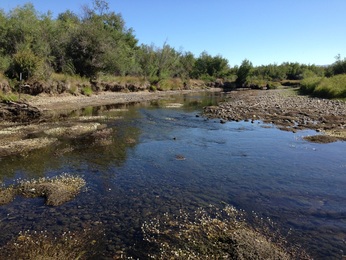 Low flow levels along the Upper Clark Fork Low flow levels along the Upper Clark Fork So, what’s the deal with water and climate change? Turns out, there are lots of connections. We dove in deep at our last monthly meetup, Thursday August 4th at Imagine Nation Brewing. We had sobering facts to consider, as well as good news to celebrate when it comes to water issues in Missoula. Chase Jones, the Energy Conservation Coordinator for the City of Missoula, said it best: Water is integral to the identity of our town. The Clark Fork River is, of course, not just a critical resource but also is the centerpiece of Missoula! One organization doing important work of keeping the river flowing and clean is the Clark Fork Coalition. Alex Leone, CFC’s Restoration Specialist, was on hand on Thursday to share about his work with the Montana Climate Office on the statewide Montana Climate Assessment, the results of which are due out next year and will focus on climate change impacts to water resources, agriculture, and forests. Alex also gave us an update on water flows, sharing the shocking news that he had just taken a flow measurement of only 2.6 cfs on the main stem of the Clark Fork almost 100 miles upriver from Missoula. Extremely low flows like this kill fish and aquatic organisms and reduce available water downstream, harming the overall health of the river. Low flows and warm water temperatures also are responsible for that pesky algae you might have seen in the river – usually, this algae gets cleared out by the tumbling action of water during peak runoff, but this year, peak runoff wasn’t high enough. These trends are likely to continue as climate change impacts spring snowmelt timing and quantities. 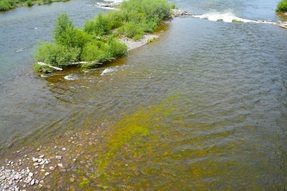 Algae in the Clark Fork River near Higgins bridge Algae in the Clark Fork River near Higgins bridge Agriculture is the major direct contributor to low flows along the Clark Fork, compounding snowmelt and peak runoff challenges. This is true elsewhere too: in Montana, agriculture accounts for 95% of water use. Greater understanding about the efficiency of flood irrigation versus overhead/sprinkler irrigation remains elusive, though much-discussed. It’s a much more complex issue than it seems on the surface: compared with sprinklers, with flood irrigation less water is absorbed by plants, but more water infiltrates through the soil and recharges the groundwater – and eventually returns to the river. Adding to the challenge of irrigation is the complexity of water rights and laws – currently, unlike the Blackfoot River, the upper Clark Fork doesn’t have a drought plan, which makes it nearly impossible to regulate water usage. Speaking of returning to the river, what about all the water that falls on our streets and flows through our pipes here in town? Travis Ross and Michelle Hutchins of the Missoula Valley Water Quality District gave us some insight into stormwater and wastewater issues. In Missoula, about 70% of our stormwater is returned to our aquifer, naturally treated through the process of infiltration on the way. This is great - less stormwater draining directly into the river means a cleaner river! On the wastewater treatment end, Missoula is also on the cutting edge: a large poplar plantation near the treatment plant receives nearly 1 million gallons a day of treated wastewater, feeding the trees (which are a great carbon sink!) and further filtering the water before it re-enters the river. Beth Schenk, the sustainability coordinator at St. Patrick Hospital, summarized the conversation well: “The lifecycle of water is important. We have a wonderful aquifer, but it matters what we put in it!” Water is clearly connected to so many other issues: waste, agriculture, even energy. Energy is one connection we don’t often think about. Not only is water a precious resource in and of itself, but pumping water to our homes and cleaning it at the wastewater treatment plant uses a ton of energy – the plant is by far the biggest municipal energy consumer. As Missoulians, conserving water helps support better water quality and quantity and reduce our carbon footprint at the same time! Water will continue to offer benefits as well as challenges in the years to come, especially as climate change impacts our region. That’s why we at Climate Smart are very excited about our City’s progress in the quest to own our water system. Local control over our water gives us the ability to talk about and deal with all the above issues and more, working for the good of our entire community! We were thrilled to be part of Sunday Streets Missoula yesterday! What could be a better way to celebrate community connections and promote healthy, active transportation? With Higgins Avenue closed to cars from 5th Street all the way to the XXXXs, Missoulians young and old came out to walk, bike, skate, scooter, and dance along the downtown corridor. Climate Smart Missoula was there to share tips on how to be Summer Smart, and provide a fun, refreshing cool-down with our DIY sprinkler! (Plenty of ideas out there for how to build your own - try Googling “DIY PVC kids sprinkler/mister”.) Check out some of our favorite photos below. We loved seeing kids and adults alike having fun with water. It’s an easy (and cheap) way to stay cool when the heat rolls in! As much as we know the importance of water conservation, using some water can be a good thing – not just for us, but for our trees, too. When it gets hot and dry out, it’s ok to neglect your lawn (brown is the new green!) but don’t forget to water your trees! They shade our homes and streets and help make our whole city cooler and healthier. Interested in continuing the conversation about water? Maybe you’ve tried to cool down by jumping in the river, and wondered about all the green algae. Join us for our next monthly meetup, Thursday, August 4th from 5-7pm at Imagine Nation Brewing Company. Folks from the Clark Fork Coalition will be on hand to chat about water quality and conservation in our changing climate. We provide snacks, INBC has delicious beer on tap - all are welcome! |
AuthorsAbby Huseth Archives
July 2024
Categories
All
|
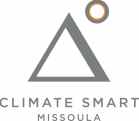
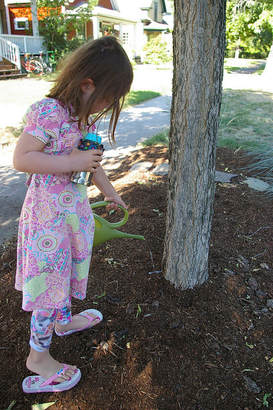
 RSS Feed
RSS Feed


